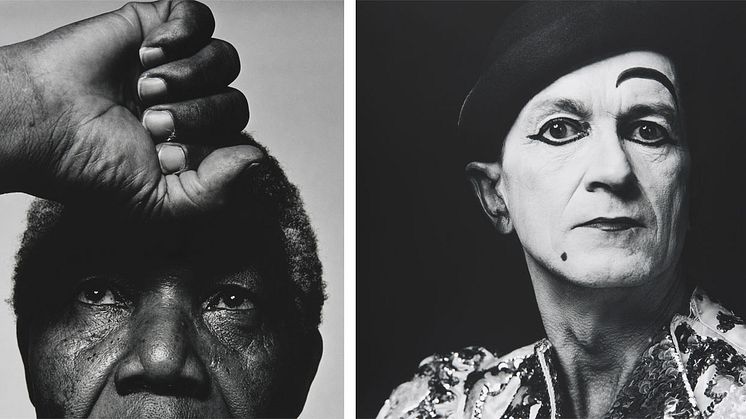
Press release -
Nationalmuseum presents Hans Gedda this winter
On 5 December, an exhibition on the life and work of photographer Hans Gedda will open at Nationalmuseum. Close to 140 works will be on show in this retrospective covering the period from the 1950s to the present day. Gedda’s celebrated portraits of Angela Davis, Andy Warhol and Nelson Mandela will appear alongside famous Swedes such as Olof Palme, Birgit Nilsson and Jonas Gardell.
Hans Gedda (born 1942) has long been recognized as one of Sweden’s most notable photographers. The coming retrospective will feature some 140 works: a mix of portraits, still lifes and semi-documentary images. The sliding scale on which the various genres are classified invites questions such as what constitutes a portrait, and what makes it different from other motifs. The featured works will cover Gedda’s long and productive artistic career from the 1950s to date.
Hans Gedda displayed a precocious talent for photography, making his artistic debut while still a teenager. The exhibition will therefore include several early works never previously exhibited. It will then trace Gedda’s ongoing development, from his student days with Teddy Aarni in Eskilstuna through the period he spent as assistant to Rolf Winquist at Ateljé Uggla. Gedda’s breakthrough came in 1967 with his portraits of Sara Lidman and Tove Jansson. As one of the dominant components of Gedda’s oeuvre, portraits will make up a major part of the exhibition. Visitors will encounter well-known images of Angela Davis, Andy Warhol, Nelson Mandela and famous Swedes such as Olof Palme, Birgit Nilsson and Jonas Gardell. In these portrayals, time and space are non-existent; everything is pared down. Examples of closeness and distance alike can be seen. One of the most innovative works is a portrait of King Carl XVI Gustaf.
Gedda has worked as a commercial photographer all his life, frequently changing perspectives and using the same models in his artistic projects. His pictures of older men with colourful personalities were created in parallel with jeans advertisements. Another example is Gedda’s circus images, commissioned by Cirkus Scott, which mix portrait photography with semi-documentary photojournalism. Since these are among the most fascinating of Gedda’s works, separate sections will be dedicated to them.
As far as self-portraits are concerned, Gedda has employed a variety of motifs as reflections of himself. He has appeared both as a white clown and as a still life in the form of scrap metal parts. In this way, he continues to experiment to this day with a sliding scale covering a number of genres such as portraiture, nature studies and still life.
As a historical counterpoint to Gedda’s contemporary imagery, a selection of works from Nationalmuseum’s collection of Caravaggisti and related artists will be on show. In early 17th-century Rome, a group of artists devised a radical painting style that was a major influence on baroque art and, later, on photography and cinema. A total of 30 oil paintings by 24 artists from six countries will be exhibited. The artists include famous names such as Jusepe de Ribera, Francisco de Zurbarán and Jacob Jordaens. Nationalmuseum does not own any originals by Caravaggio, on whom these artists modelled themselves, but does possess a high-quality collection of works by his followers. Their distinctive features are strong contrasts between light and dark, dramatic narratives, and real, flesh-and-blood characters. The strong emotional expression and tense, almost aggressive composition have appealed to contemporary filmmakers such as Scorsese, Jarman and Pasolini. Although more than three centuries separate the Caravaggisti from Hans Gedda’s images, they have many features in common.
To coincide with the exhibition, a lavishly illustrated catalogue will be published in Swedish and English. It will contain two essays by Magnus Olausson and Eva-Lena Karlsson, the exhibition curators, which will draw extensively on numerous conversations with Gedda.
The exhibition will open on 5 December 2013 in Nationalmuseum’s temporary venue at Konstakademien, Fredsgatan 12, Stockholm, and will run until 30 March 2014.
Further information
Magnus Olausson, exhibition curator, magnus.olausson@nationalmuseum.se, +46 8 5195 4371
Hanna Tottmar, press officer, hanna.tottmar@nationalmuseum.se, +46 8 5195 4390
Press images
www.nationalmuseum.se/pressroom
Captions
Hans Gedda, Unknown Man, about 1995; Nelson Mandela, 1990; Self Portrait as the White Clown, 2001. The images are cropped.
Nationalmuseum is Sweden’s premier museum of art and design. The collections comprise older paintings, sculpture, drawings and graphic art, and applied art and design up to the present day. The museum building is currently under renovation and scheduled to open again in 2017. In the meantime, the museum will continue its activities through collaborations, touring exhibitions and a temporary venue at the Royal Swedish Academy of Fine Arts, Fredsgatan 12, Stockholm. Nationalmuseum collaborates with Svenska Dagbladet, Fältman & Malmén and Grand Hôtel Stockholm. For more information visit www.nationalmuseum.se.

